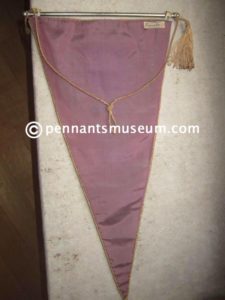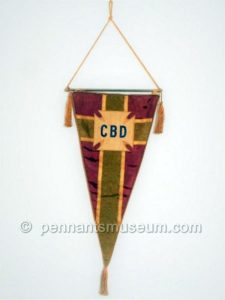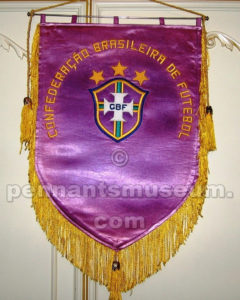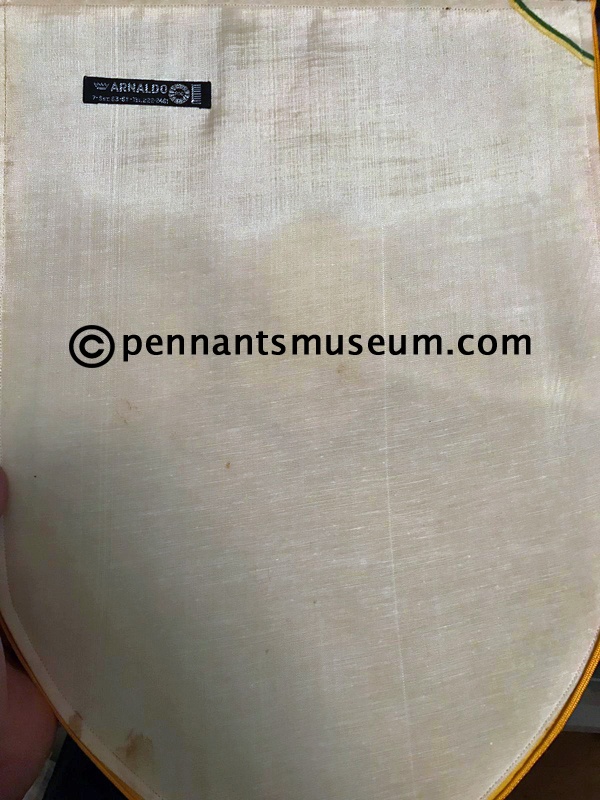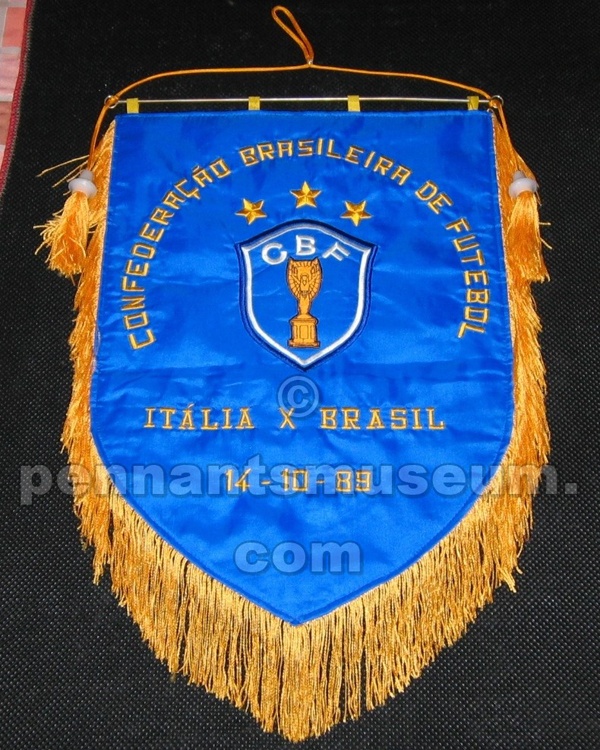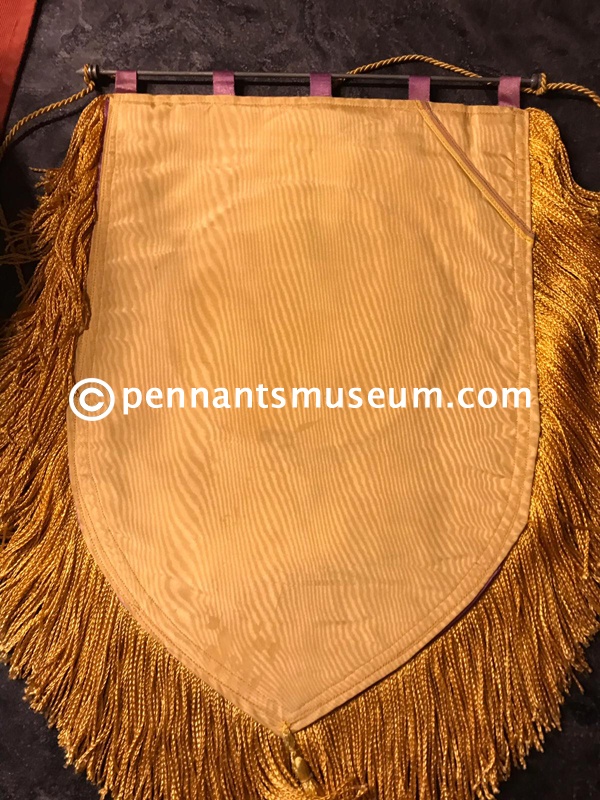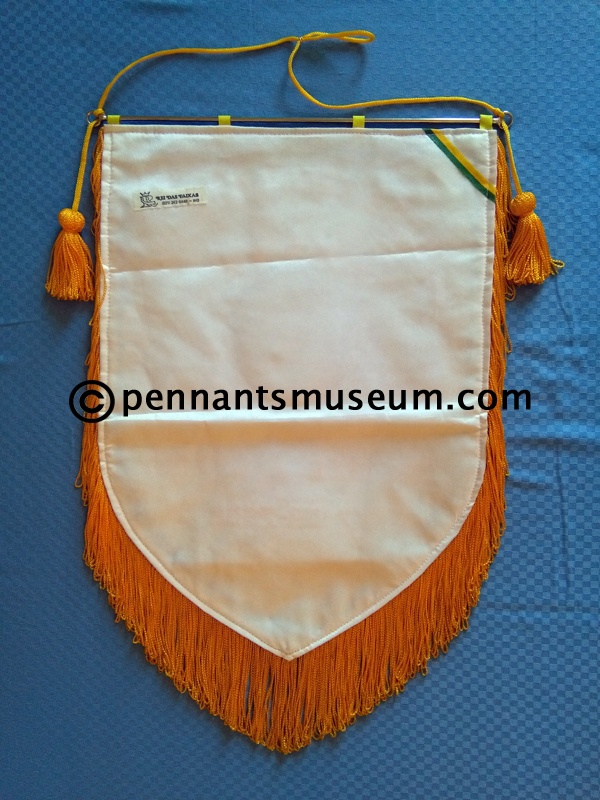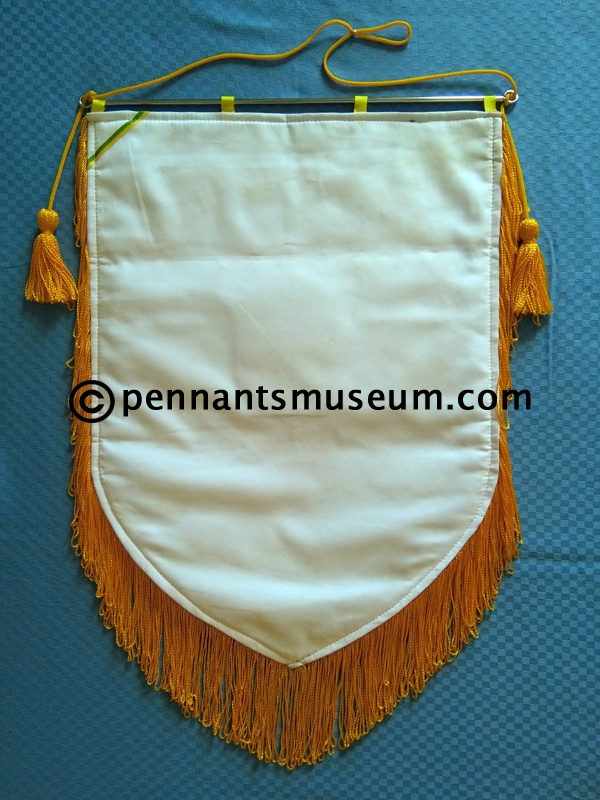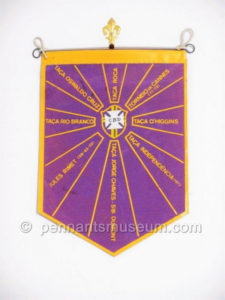![]()
Il collezionismo è fatto di tante storie. Passione, sacrifici, dedizione ed irrefrenabile impegno nel sapere e conoscere. Ed è proprio la passione e la curiosità di apprendere, ed in questo caso approfondire la storia di calcio, che rende nobile il “folle” e oscuro lavoro di tanti appassionati. Perché solo pura follia può spingere a cercare di dare una ragione ad un disegno di una piantina di caffè abbinato al simbolo di una federazione oppure scoprire che, la stessa nazionale, per la Coppa del Mondo utilizzò gagliardetti praticamente ideati quasi esclusivamente per quella competizione. Ebbene sì quanto sopra è vero e se poi viene associato alla nazionale brasiliana tutto diventa molto più interessante.
L’ultimo arrivo in collezione, mi consente un approfondimento legato alle varie tipologie di gagliardetti utilizzati dalla Seleçao nel corso degli anni. Quest’ultimo gagliardetto, infatti, fa parte di una nuova realizzazione che è stata avviata nel corso del 2019 a partire dall’amichevole di giugno con il Qatar e presenta il nuovo scudetto della CBF, scudetto che dal 2020 sarà presente anche sulle maglie da gioco.
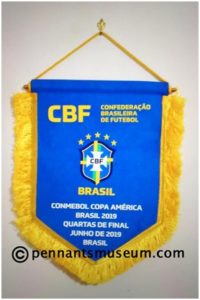
Contrariamente agli storici gagliardetti dei verde-oro tutti interamente ricamati, questo è un modello stampato, tipologia che il Brasile ha iniziato ad utilizzare dall’amichevole con il Messico nel giugno 2015, abbandonando lo storico modello di gagliardetto a forma di scudo prodotto dalla Ditta “Rei das Faixas” di Rio de Janeiro.
La collaborazione della Federazione Brasiliana con questa Società è stata davvero storica basti pensare che già agli inizi degli anni 60 venivano prodotti da “Rei” i gagliardetti per la nazionale verde-oro (allora “Rei da Faixas” aveva la denominazione “Arnaldo” dal nome del suo fondatore). Negli anni 50 e precedenti, eccetto rare occasioni come la “Copa Roca” o la “Taça Bernardo O’Higgins”, il Brasile utilizzava gagliardetti prevalentemente triangolari riportanti al centro il logo a croce della stessa federazione, la CBD “Confederação Brasileira de Desportos”, il produttore anni 50′ era “Superball”.
Si parla di CBD, perchè la CBF “Confederação Brasileira de Futebol” fu creata nel 1979 in sostituzione della vecchia CBD, che riuniva sotto un’unica sigla tutti gli sport.
La CBF “Confederação Brasileira de Futebol” nel 1982 fece una modifica al proprio simbolo nello scudetto; la croce in uso fino a quel momento venne sostituita (dopo un concorso in Brasile) dalla Coppa Rimet (simbolo delle tre vittorie al mondiale) con sopra in bianco le tre lettere C – B – F.
Questo nuovo scudetto rimase in voga fino al 1991, quando la CBF adottò nuovamente la croce antica.
Altra curiosità fù l’introduzione all’interno accanto alla coppa del simbolo del caffè (Instituto Brasileiro do Café – IBC) simbolo che dalle maglie fu poi tolto per ordine FIFA ai mondiali in Messico nel 1986, ma nei gagliardetti rimase anche durante parte del 1987.
Come accennato precedentemente, nel periodo CBD, la “Flâmula” (gagliardetto) triangolare è talvolta sostituita, in modo eccezionale, come nel bellissimo gagliardetto a scudo commemorativo della “Copa Roca” Argentina – Brasile giocata nel 1957.
Alcune curiosità dei gagliardetti del Brasile, sono anche per la Coppa del Mondo 1962 in Cile, dove il Brasile nella prima fase a gruppi aveva il gagliardetto grande a scudo, poi nella fase finale, invece, scambiava il gagliardetto triangolare classico.
Anche nel 1968, una eccezione, per l’amichevole contro una Selezione della FIFA il Brasile ebbe un gagliardetto a scudo grande con il logo CBD e il logo FIFA separati da una fascia in diagonale.
Nel 1970 e nel 1974 nel corso dei mondiali il Brasile utilizzò dei gagliardetti riportanti una figura di fantasia anziché lo stemma CBD della federazione.
Nello specifico quello del 1970 fu usato anche in amichevole pre-mondiale, quello del 1974, venne utilizzato solo nel periodo del mondiale, quindi in ambo i casi furono gagliardetti realizzati in pochi esemplari, ciò conferisce a tali pezzi un’estrema rarità e valore storico.
Altra caratteristica è il retro dei gagliardetti brasiliani, quanto meno quelli realizzati da Arnaldo e Rei da Faixas. Tali materiali infatti presentavano sempre nel retro l’etichetta rettangolare con il nome del produttore nonché sul lato destro due sottili righe orizzontali riportanti il giallo ed il verde della bandiera brasiliana.
Tali dettagli hanno subito variazioni nel corso del tempo, l’etichetta del produttore (Arnaldo – Rei das faixas) è stata presente fino al 2007, dal 2008 è scomparsa.
Le strisce (verde e gialla) hanno mutato spessore e ordine, talvolta presentandosi invertite, inoltre sono state presenti sempre sul lato destro, eccetto nell’anno 2011, quando sono passate a sinistra, per poi scomparire e lasciare il retro completamente bianco fino all’anno 2015.
Attualmente il nuovo modello di gagliardetto, invece ha il retro nella stessa colorazione del fronte, blu.
Molto usato dalla nazionale brasiliana era lo scambio dei cosiddetti gagliardetti da giocatore.
Di dimensioni molto ridotte ed analogo a quello più grande che veniva consegnato al Capitano della squadra avversaria, questo vessillo era usualmente consegnato ai giocatori avversari prima degli incontri nelle competizioni ufficiali come il Mondiale e la Coppa America.
Infine, oltre ai due tipi utilizzati nel corso dei mondiali, il Brasile ha anche utilizzato per brevissime occasioni dei gagliardetti che costituiscono un vero oggetto del desiderio collezionistico.
Due esempi su tutti.
Il gagliardetto relativo al 70° anniversario della costituzione della Federazione Brasiliana, ricorrenza immortalata su di uno stupendo gagliardetto consegnato al capitano della formazione inglese per l’amichevole giocata nel 1984, e in altre partite di quell’anno.
Oppure un fantasioso gagliardetto riportante le maggiori vittorie della Seleçao Brasileira che fu utilizzato in pochissime partite nel 1973.
Si può certamente dire che al Brasile non manca certamente la fantasia e l’attenzione che viene riposta nella produzione dei propri gagliardetti ufficiali.
 THE SELEÇAO AND ITS PENNANTS
THE SELEÇAO AND ITS PENNANTS
Collecting is made up of many stories. Passion, sacrifices, dedication and unstoppable commitment to knowledge and knowledge.
And it is precisely the passion and the curiosity to learn, and in this case to deepen the history of football, which makes noble the “crazy” and obscure work of many collectors.
Because only pure madness can push you to try to give a reason to a drawing of a coffee plant paired with the symbol of a federation or to discover that, for the World Cup itself, the same national team used pennants practically designed almost exclusively for that competition. Well yes the above is true and if it is then associated with the Brazilian national team everything becomes much more interesting.
The latest arrival in the collection allows me to learn more about the various types of pennants used by the Seleçao over the years.
This last pennant, in fact, is part of a new realization that was started during 2019 starting from the June friendly match with Qatar and presents the new CBF championship, a championship that from 2020 will also be present on the gaming jerseys.
Contrary to the historic green-gold pennants, all entirely embroidered, this is a printed model, a type that Brazil started using from the friendly with Mexico in June 2015, abandoning the historic shield-style pennant model produced by the Company ” Rei das Faixas “of Rio de Janeiro.
The collaboration of the Brazilian Federation with this company has been truly historic, just think that in the early 60s the pennants for the national green-gold were produced by “Rei” (then “Rei da Faixas” had the name “Arnaldo” from the name of its founder). In the 1950s and earlier, except for rare occasions such as the “Copa Roca” or the “Taça Bernardo O’Higgins”, Brazil used predominantly triangular pennants bearing the cross logo of the same federation, the CBD “Confederação Brasileira de Desportos” , the 50s producer was “Superball”.
There is talk of CBD, because the CBF “Confederação Brasileira de Futebol” was created in 1979 to replace the old CBD, which brought together all sports in a single abbreviation. The CBF “Confederação Brasileira de Futebol” in 1982 made a change to its symbol in the league title, the cross in use until then was replaced (after a competition in Brazil) by the Rimet Cup (symbol of the three victories in the world championship) with above in white the three letters C – B – F. This new championship remained in vogue until 1991, when the CBF again adopted the ancient cross.
Another curiosity was the introduction inside, next to the cup of the coffee symbol (Instituto Brasileiro do Café – IBC), a symbol that was then removed from the jerseys for FIFA order at the World Cup in Mexico in 1986, but in pennants it remained even during part of 1987 As mentioned above, in the CBD period, the triangular pennant is sometimes substituted, in an exceptional way, like in the beautiful commemorative shield pennant of the “Copa Roca” Argentina – Brazil played in 1957.
Some curiosities of the Brazilian pennants , they are also for the 1962 World Cup in Chile, where Brazil had the big shield-shaped pennant in the first group stage, then in the final phase, instead, it exchanged the classic triangular pennant. Also in 1968, an exception, for the friendly against a Selection of FIFA, Brazil had a big shield pennant with the CBD logo and the FIFA logo separated by a diagonal band.
In 1970 and 1974 during the World Cup Brazil used pennants bearing a fantasy figure instead of the federation’s CBD emblem.
Specifically, the one from 1970 was also used in a pre-world friendly, that of 1974, was used only during the World Championship, so in both cases they were pennants made in a few specimens, which gives these pieces an extreme rarity and historical value . Another feature is the back of Brazilian pennants, at least those made by Arnaldo and Rei da Faixas.
In fact, these materials always had a rectangular label on the back with the name of the manufacturer and on the right side two thin horizontal lines showing the yellow and green of the Brazilian flag. These details have changed over time, the manufacturer’s label (Arnaldo – Rei das faixas) was present until 2007, since 2008 it has disappeared.
The strips (green and yellow) have changed thickness and order, sometimes appearing inverted, moreover they have always been present on the right side, except in the year 2011, when they passed to the left, only to disappear and leave the back completely white until year 2015. Currently the new pennant model, instead it has the back in the same color of the front, blue. Much used by the Brazilian national team was the exchange of so-called player pennants.
Very small in size and similar to the larger one that was given to the captain of the opposing team, this banner was usually handed over to the opposing players before the matches in official competitions such as the World Cup and the America’s Cup. Finally, in addition to the two types used during the World Championships, Brazil also used pennants for a very short time, which are a real object of collecting desire.
Two examples above all.
The pennant related to the 70th anniversary of the establishment of the Brazilian Federation, a celebration immortalized on a beautiful pennant given to the captain of the English formation for the friendly match played in 1984, and in other matches of that year. Or an imaginative pennant showing the greatest victories of the Seleçao Brasileira which was used in very few matches in 1973.
It can certainly be said that Brazil certainly does not lack the imagination and attention that is placed in the production of its own official pennants.
Pubblicato anche sul sito amico: gli glieroidelcalcio.com


